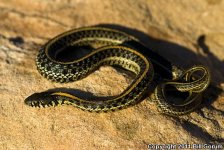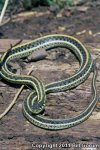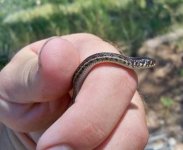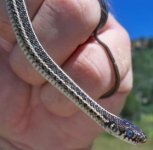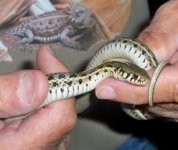| Range: |
 |
| Other Names: |
Garden Snake, Gardener Snake, Grass Snake |
| Description: |
Mostly gray, greenish gray or a gray brown. A well defined yellowish
to whitish middorsal stripe down the back. Olive gray to olive brown
above, with alternating rows of black or brown spots. Belly light
gray, gray white with scattered black speckling or spotting. Scales
are keeled. Adults are 14"-42" in length.
|
| Similar Species: |
Patchnoses and whipsnakes have smooth scales, a divided anal plate and no spots. The Blackneck, Mexican, Checkered all have prominent dark neck blotches. Terrestrial and Common garters both have the lateral stripe on scale rows two and three. |
| Venom: |
Garters were long thought to be nonvenomous, but recent discoveries have revealed that they do in fact produce a mild neurotoxic venom. Garter snakes cannot kill humans with the small amounts of venom they produce, which is comparatively mild, and they also lack an effective means of delivering it. They do have enlarged teeth in the back of their mouth, but their gums are significantly larger. The Duvernoy's gland of garters are posterior (to the rear) of the snake's eyes. The mild venom is spread into wounds through a chewing action. - Wikipedia |
| Habitat: |
Inhabits wet prairies, farmland, grassland, but ranges into
pinon-juniper belt, pine fir and aspen forests. Frequents permanent,
intermittent streams and springs. |
| Behavior: |
Will emit a fouls smelling musk if handled. |
| Hibernation: |
|
| Reproduction: |
Live bearers, mate in the spring. |
| Diet: |
Feeds on frogs, toads, tadpoles, fish, salamanders, lizards, small
mammals and earthworms. |
Authored by: Garth Teitjen
Sources:



|



